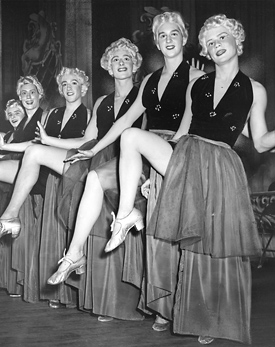The new Bentley Historical Library exhibit “A Queer Timeline: 1846-2012” celebrates the gamut of Gay, Lesbian, Bisexual, Transgender and Queer (GLBTQ) history — from the triumph of the human spirit prevailing over discrimination, to the campy fun people find in gender bending.
Exhibit curator JJ Pionke, a master’s student in the School of Information, created both a physical exhibit at the Bentley Library through November, and an ongoing online exhibit at bentley.umich.edu/exhibits/queer.

This photo of a group of male Michigan Opera students in 1952 is presented in the Bentley Historical Library exhibit “A Queer Timeline: 1846-2012.” Photo by Courtesy Bentley Historical Library.
“It’s about being human. It’s not about what divides us but what brings us together. Who I sleep with and what I look like should not matter,” Pionke says.
Among the most striking exhibit items are records of the 1970s struggles of gay students and activists seeking representation at the university and in the Ann Arbor political scene. Pionke says her favorite artifact from that period details an exchange between a graduate instructor and a university representative, during a discussion over gender-appropriate attire.
“The negotiator from the university said you can’t have men dressed as women teaching classes, they said it would be inappropriate. The student responded that the instructor might be a fire-breathing stud, but if he wants to wear a dress once in a while, why not? It shouldn’t matter what I wear or how I look, as long as I can teach and do the job,” she says.
From Bentley Library collections, Pionke also found photos that celebrate gender bending or a gay perspective. Images include a smiling Albert Einstein holding a puppet given to him in the 1940s by gay U-M alumnus and professional puppeteer Forman Brown, and smiling 1952 Michigan Opera students in a chorus line dressed as women.
Pionke says it was important to portray serious matters such as the fight for equal rights, along with the fun of gender bending.
“I’ve always found it very fascinating how we construct gender. In this chorus line of men dressed as women, they’re wearing high heels and have their legs up; it’s clear that they’re men, and that they know they’re men and they’re digging the idea that ‘We’re men dressed as women — Yeah!’ What’s not to love about that picture?” she says.
“Ann Arbor and the University of Michigan have always been on the forefront of a lot of things and gay rights has been one of them. But it hasn’t been without controversy,” Pionke says.
When the administration rejected a 1970 conference on campus sought by the Gay Liberation Front, “The students went ahead and held it anyway,” Pionke says. “I was really struck by the tenacity of the students here in the 1970s. The fact that students of U-M were leading the way for the country is very impressive. We had the first openly gay politicians in Ann Arbor in the nation, they were part of the Human Rights Party.” Students and activists in 1972 organized the first Gay Pride Week in the nation, the timeline shows.
The exhibit’s construction was inspired by a timeline produced by the School of Information’s Lavender Information and Library Association. LILA promotes awareness of GLBTQ issues within SI, the university library system and throughout the university.
In 1971, Jim Toy and Cyndi Gair were named the university’s first human sexuality advocates, dealing with gay and lesbian issues on campus. The exhibit includes a 2000 photo of Toy and lesbian activist Ruth Ellis at her 100th birthday party. Ellis was known nationwide for founding a Detroit center for young GLBTQ people seeking to escape abuse.
Also on display is a legislative proclamation honoring Jim Dressel, a former Republican state representative who sponsored an anti-discrimination law based on sexual orientation in 1983. “The sponsoring of that bill cost him his career as a politician and he was ostracized by his colleagues. He later came out of the closet and (later) died of AIDS. The proclamation honors his service after his death,” Pionke says.
Also housed in the Bentley exhibit is a collection of pins from the Gay Games, started in 1990 as an alternative Olympics, and newspaper clippings revealing how the public and news media responded to the growing AIDS epidemic in the 1980s.
“Very often GLBTQ history is hidden history it has been lost, you have to dig to find it,” Pionke says, adding she had much help from Karen Jania, Bentley Library reference archivist. “But in the collection at U-M and specifically the Bentley you don’t have to go very deep, its there. I learned a lot.”

